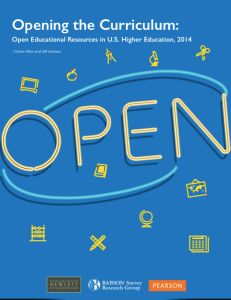For years we have heard anecdotes and case studies about OER adoption based on one (or a handful) of institutions. There are many items we think we know, but we have lacked hard data on the adoption process to back up these assumptions that have significant policy and ed tech market implications.

While there will be other posts (including my own) that will cover the immediate findings of this survey, I think it would be worthwhile to first provide context on why this is a significant milestone. Most of the following background and author findings is based on my interview with Dr. Jeff Seaman, one of the two lead researchers and authors of the report (the other is Dr. I. Elaine Allen).
Background
Three years ago when the Survey for Online Learning was in its 9th iteration, the Hewlett Foundation approached BSRG about creating reports on OER adoption. Jeff did a meta study to see what data was already available and was disappointed with results, so the group started to compile surveys and augment their own survey questionnaires.
The first effort, titled Growing the Curriculum and published two years ago, was a combination of results derived from four separate studies. The section on Chief Academic Officers was “taken from the data collected for the 2011 Babson Survey Research Group’s online learning report”. This report was really a test of the survey methodology and types of questions that needed to be asked.
The Hewlett Foundation is planning to develop an OER adoption dashboard, and there has been internal debate on what to measure and how. This process took some time, but once the groups came to agreement, the current survey was commissioned.
Pearson came in as a sponsor later in the process and provided additional resources to expand the scope of survey, augmented the questions to be asked, and helped with infographics, marketing, and distribution.
A key issue on OER adoption is that the primary decision-makers are faculty members. Thus the current study is based on responses from teaching faculty “(defined as having at least one course code associated with their records)”.
A total of 2,144 faculty responded to the survey, representing the full range of higher education institutions (two-year, four-year, all Carnegie classifications, and public, private nonprofit, and for-profit) and the complete range of faculty (full- and part-time, tenured or not, and all disciplines). Almost three-quarters of the respondents report that they are full-time faculty members. Just under one-quarter teach online, and they are evenly split between male and female, and 28% have been teaching for 20 years or more.
Internal Lessons
I asked Jeff what his biggest lessons have been while analyzing the results. He replied that the key meta findings are the following:
- We have had a lot of assumptions in place (e.g. faculty are primary decision-makers on OER adoption, cost is not a major driver of the decision), but we have not had hard data to back up these assumptions, at least beyond several case studies.
- The decision process for faculty is not about OER – it is about selecting teaching resources. The focus of studies should be on this general resource selection process with OER as one of the key components rather than just asking about OER selection.
Thus the best way to view this report is not to look for earth-shaking findings or to be disappointed if there are no surprises, but rather to see data-backed answers on the teaching resource adoption process.
Most Surprising Finding
Given this context, I pressed Jeff to answer what findings may have surprised him based on prior assumptions. The two answers are encouraging from an OER perspective.
- Once you present OER to faculty, there’s a real affinity and alignment of OER with faculty values. Jeff was surprised more about the potential of OER than he had thought going in. Unlike other technology-based subjects of BSRG studies, there is almost no suspicion of OER. Everything else BSRG has measured has had strong minority views from faculty against the topic (online learning in particular), with incredible resentment detected. This resistance or resentment is just not there with OER. It is interesting for OER, with no organized marketing plan per se, to have no natural barriers from faculty perceptions.2
- In the fundamental components of OER adoption – such as perceptions of quality and discoverability and currency – there is no significant difference between publisher-provided content and OER.
Notes on Survey
This is valuable survey, and I would hope that BSRG succeeds in getting funding (hint, hint Hewlett and Pearson) to make this into an annual report with longitudinal data. Ideally the base demographics will increase in scope so that we get a better understanding of the unique data between institution types and program types. Currently the report separates 2-year and 4-year institutions, but it would be useful to compare 4-year public vs. private and even for program type (e.g. competency-based programs vs. gen ed vs. fully online traditional programs).
There is much to commend in the appendices of this report – with basic data tables, survey methodology, and even the questionnaire itself. Too many survey reports neglect to include these basics.
You can download the full report here or read below. I’ll have more in terms of analysis of the specific findings in an upcoming post or two.
[gview file=”https://eliterate.us/wp-content/uploads/2014/10/Opening-the-Curriculum.pdf” save=”1″]
- Disclosure: Pearson is a client of MindWires Consulting – see this post for more details. [↩]
- It’s no bed of roses for OER, however, as the report documents issues such as lack of faculty awareness and the low priority placed on cost as a criteria in selecting teaching resources. [↩]
[…] Milestone: First national study of OER adoption” Posted on October 29, 2014 by Phil Hill _ https://eliterate.us/significant-milestone-first-national-study-oer-adoption/ __ Measuring Awareness of Open Educational Resources OER started with difficult decisions and […]